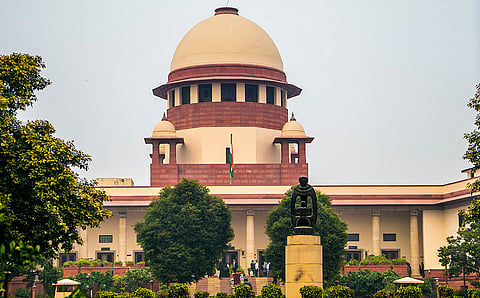Supreme Court's Directive on VVPAT Tallying Renews Transparency Concerns in Lok Sabha Elections 2024
New Delhi- Amidst growing concerns over electoral transparency, the Supreme Court of India has issued a notice to the Election Commission of India (ECI) on April 1st. This notice comes in response to a plea filed by lawyer and activist Arun Kumar Agrawal, urging for a comprehensive tallying of Voter-Verifiable Paper Audit Trail (VVPAT) slips during elections. Justices BR Gavai and Sandeep Mehta have directed the ECI to address the matter, sparking renewed debate and scrutiny over the electoral process.
Agrawal's petition contested a guideline set by the Election Commission mandating a sequential process for VVPAT verification, arguing that it leads to unnecessary delays. Instead, the petitioner suggests conducting verification simultaneously and deploying additional personnel to speed up the process, estimating completion within 5-6 hours per assembly constituency.
The plea aims to revoke Guideline No. 14.7(h) of the Manual on Electronic Voting Machine and VVPAT issued by the Election Commission in August 2023, which only allows for sequential verification of VVPAT slips.
Agrawal raised concerns about insufficient verification of VVPATs despite substantial government spending on their acquisition. Given past discrepancies between EVM and VVPAT vote counts and expert concerns, it is deemed crucial to meticulously count all VVPAT slips.
Furthermore, the plea argued that voters should be permitted to physically deposit their VVPAT slips in a ballot box to ensure the accurate recording of their votes, which has not been addressed yet. This plea joins other pending cases concerning EVMs and VVPATs.
EVM Hatao Sanyukt Morcha, a collective of socially active citizens and Supreme Court lawyers, has been raising doubts regarding the election process and the lack of transparency of VVPATs for many months. DC Kapil, an engineer who is a member of the collective, spoke to The Mooknayak regarding the recent notice.
He said, “Since the first day, we were speaking about the lack of transparency in the election process. The notice addresses our contention in a way but not as a whole.” He further stated that the collective is still not happy with the decision because the VVPAT slips still directly slip into a drop box. If the slips are handed to the voters and they get to put them in the box, they will be able to be sure that they have, in fact, voted for the political party or candidate they wanted to. This has not been addressed by the notice, according to the engineer.
Supreme Court advocate Mehmood Pracha, who has been in the forefront of the movement, stated that the order came too late. He further questioned if it will be even applicable in the upcoming Lok Sabha elections, which are already knocking at our doors.
How Votes Are Cast in the Country
In India, Electronic Voting Machines (EVMs) are employed for electronic voting. These machines consist of two main units: a Control Unit and a Balloting Unit, linked by a five-meter cable.
The Control Unit is placed under the supervision of the Presiding Officer or a Polling Officer, while the Balloting Unit is positioned inside the voting booth. Instead of using traditional paper ballots, the voting process is initiated by the Polling Officer operating the Control Unit, who presses the Ballot Button.
This action triggers the display of a digital ballot on the Balloting Unit, enabling voters to cast their votes by pressing the blue button corresponding to their chosen candidate and symbol.
In order to enhance transparency and allow voters to verify the accuracy of their votes, an integrated Voter Verifiable Paper Audit Trail (VVPAT) system accompanies the EVMs. The VVPAT produces a printed slip containing crucial details such as the serial number, name, and symbol of the selected candidate.
This printed slip is visible through a transparent window for seven seconds, allowing voters to confirm their choices. Afterward, the slip is automatically cut and securely deposited into the sealed drop box of the VVPAT, thereby upholding the integrity of the voting process.
History of the Contention
Before the 2019 Lok Sabha elections, there was a significant push from leaders of approximately 21 opposition political parties to ensure the integrity of the electoral process.
They approached the Supreme Court seeking an increase in the verification of Voter-Verifiable Paper Audit Trail (VVPAT) slips. VVPATs serve as a paper trail to verify that the vote cast by a citizen using an Electronic Voting Machine (EVM) is correctly recorded.
The opposition parties urged that at least 50 percent of all EVMs should undergo VVPAT verification to enhance transparency and confidence in the electoral process. During this period, the Election Commission of India (ECI) followed a protocol where only one randomly selected EVM per assembly segment was cross-checked with its corresponding VVPAT slip. However, in response to the plea submitted by the opposition parties, on April 8, 2019, the Supreme Court decided to increase the number of EVMs subject to VVPAT verification from one to five per assembly segment. This move aimed to further ensure the accuracy and fairness of the electoral outcomes.
Following this decision, in May 2019, the Supreme Court dismissed another plea filed by a group of technocrats who advocated for VVPAT verification for all EVMs. However, even as the Supreme Court addressed these concerns and enhanced the scrutiny of the electoral process, it also cautioned against excessive scepticism through Public Interest Litigations (PILs).
In July of the following year, the Court remarked that some PILs concerning election processes may inadvertently undermine public confidence in the integrity of the electoral system. Despite these developments, a plea filed by the Association for Democratic Reforms requesting the cross-verification of VVPAT slips with votes cast through EVMs remains pending before the Court. Presently, the standard practice involves verifying VVPAT slips for votes recorded in five randomly selected EVMs in each assembly segment.
You can also join our WhatsApp group to get premium and selected news of The Mooknayak on WhatsApp. Click here to join the WhatsApp group.

